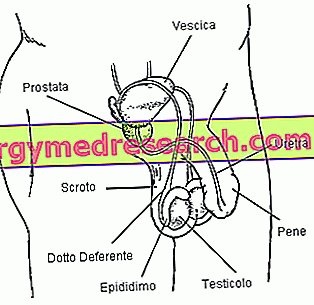Generality
Ejaculation is the act by which man emits seminal fluid from the penis, a fluid originating in the prostate containing the spermatozoa.
In humans, ejaculation is the conclusive part of orgasm and takes place after adequate stimulation of the erogenous zones and sexual organs.

The volume of sperm and the quantity of spermatozoa emitted with the semen vary according to a number of different factors (for example, the time between two ejaculations, etc.).
A very similar argument also applies to the refractory period, ie the time that must elapse before one can have another ejaculation.
Ejaculation is not always optimal: the disorders that concern it are varied and will be briefly illustrated in the rest of the article.
What is ejaculation?
Ejaculation is the term that usually indicates the act of emitting seminal fluid from the penis, or the male reproductive organ.
So, in the absence of adjectives or other specifications, the only word "ejaculation" concerns the male sex. For more information on female ejaculation click here.
For man, ejaculation represents the final part of orgasm, an orgasm that is the maximum expression of sexual excitation resulting from the stimulation of the erogenous zones and sexual organs.
Except in special cases (for example subjects subjected to vasectomy), the seminal fluid expelled during ejaculation contains numerous spermatozoa . Seminal fluid containing sperm takes the specific name of sperm .
ANATOMICAL BRIEF REVIEW OF THE MALE GENITAL APPARATUS
The fundamental elements of the male genital apparatus are:
- The testicles or didymas . Contained in the scrotum, they are the male gonads . Their job is to produce sperm and the important testosterone hormone.
- The prostate and seminal vesicles . The prostate is the gland that produces seminal fluid. The seminal fluid, in addition to collecting the spermatozoa (sperm), also provides for their nutrition.
In number of two, the seminal vesicles produce a liquid similar to seminal fluid.
- The epididymis and the vas deferens of each testicle. The epididymis and the vas deferens are the channels that join the testicles to the seminal vesicles and the prostate and which inject into the latter the spermatozoa.
- The urethra . The urethra is a small canal that begins at the level of the bladder, runs all over the penis and is used to expel urine and sperm. The expulsion of urine and sperm occurs through the urinary meatus, located on the glans penis.

- The penis . The penis is the anatomical structure responsible for the elimination of urine and the passage of sperm from man to woman.
Features
Preceded by the erection of the penis, ejaculation comes at the end of adequate sexual stimulation.
The sympathetic nervous system controls the emission of sperm from the penis.
The latter, in fact, by means of the so-called pudendal nerve, stimulates the bulbospongyous and pubococcygeus muscles to perform rhythmic contractions, capable of moving the sperm along the urethra, up to the urinary meatus positioned on the glans.
Generally, the contractions that characterize a classic ejaculation are 10 or slightly more: the first are clearly more perceptible than the terminal ones and also coincide with a greater emission of sperm (NB: very often, man does not even notice terminal contractions) .
If before the beginning of the contractions the man is able to control more or less effectively the emission of the sperm, after the first contraction the ejaculation assumes the contours of an involuntary process. In other words, after the first contraction, it is impossible to voluntarily interrupt ejaculation.
The contractions that lead to the emission of the sperm have a total duration of a few seconds.
Several men experience additional contractions even at the end of an orgasm.
WHAT IS THE PRE-EIACULATORY FLUID?
Prolonged sexual stimulation has the effect of producing a liquid, known as a pre-ejaculatory fluid . At the time of its production, the pre-ejaculatory fluid has no spermatozoa; however, it could contain them at the time of its emission through the urinary meatus, as it collects the sperm residues that have stopped along the urethra, during a previous ejaculation.
REFRACTORY PERIOD
The lapse of time between the end of an ejaculation and the possibility of having another erection and, possibly, another ejaculation is called a refractory period .
In other words, the refractory period is that post-orgasm phase, in which man is unable to have another ejaculation.
During the refractory period, men experience a pleasant sensation of relaxation .
The duration of the refractory period is variable and depends on several factors. Among these factors there is certainly age: for a person aged 18, the refractory period is about 15 minutes; while for an elderly man, it is at least 20 minutes.
It is however good to point out that there are exceptions, that is, elderly individuals with a refractory period equal to that of an 18 year old.
Curiously, there are men capable of having multiple orgasms, or rather organisms between which there is a minimum refractory period (10 seconds) if not zero.
VOLUME
The volume of seminal fluid (regardless of whether or not it contains spermatozoa) varies from human to human and can range from 0.1 milliliters to even 10 milliliters .
In adult men, the amount of seminal fluid emitted during an ejaculation (or ejaculate ) depends first of all on how much time has elapsed since the previous ejaculation: the longer the time that separates two consecutive ejaculations, the more conspicuous the volume of seminal fluid emitted ( NB: there is clearly a physiological limit). This means that, after long periods of abstinence, the amount of ejaculate is generally high.
Another factor that can affect the amount of semen released at the time of ejaculation is the duration of sexual stimulation: long-term sexual stimulation reduces the volume of the ejaculate (but determines, as you will remember, the production of the fluid pre-ejaculatory).
More than 40% of the seminal fluid emitted during an ejaculation emerges between the first and second contraction induced by the pudendal nerve and which involves the bulbospongius and pubococcygeus muscles.
With the following contractions, the volume of the ejaculate tends to gradually decrease.
QUALITY
For quality of an ejaculation, the experts intend the concentration of spermatozoa present in the seminal fluid.
The quality of an ejaculate depends on different factors, including:
- The time elapsed since the last ejaculation . The more time passes between two consecutive ejaculations, the higher the sperm concentration of the second ejaculation.
Conversely, if little time passes between two consecutive ejaculations, the seminal fluid of the second ejaculation will contain a reduced number of spermatozoa.
- Age . In a healthy young adult, the sperm concentration of the ejaculate is higher than that of an adult in middle age or advanced age and in good health.
Young people just after puberty represent a special case, because, in these individuals, the sperm production mechanism is not yet fully formed.
- Stress levels . Stress affects the production of sperm from the testicles, so the ejaculate suffers.
- Testosterone levels . The higher the production of testosterone, the greater the production of sperm by the testicles.
- The duration of sexual stimulation . Generally, prolonged sexual stimulation ends with the emission of an ejaculate rich in spermatozoa (more than would occur as a result of short-term sexual stimulation).
Development
According to some scientific and statistical studies, the first ejaculation of a man would take place around 12 months after the onset of puberty, through an act of masturbation or a nocturnal pollution.
The volume of the first ejaculate is usually very small, less than a milliliter, and remains so for at least three months (from the first ejaculation).
The first ejaculations determine the production of a seminal liquid of a particularly clear color, with a gelatinous appearance and poor in spermatozoa.
On the sperm concentration of the first ejaculations, the experts report that:
- About 90% of the first ejaculations are free of sperm.
- In those few ejaculations containing sperm, these are almost always (97% of the cases) static, lacking in motility.
As pubertal development proceeds, sperm concentration increases.
Over time and after several ejaculations, the consistency of the seminal fluid also varies, becoming much more fluid from gelatinous.
Generally, if the first ejaculation took place during puberty, the seminal fluid of a young person takes on the characteristics of an adult's seminal fluid after about 24 months from the first ejaculate release.
Abnormalities
There are several abnormalities / disorders of ejaculation, which may relate to the act of sperm emission, the volume of ejaculate emitted or the concentration of sperm in the seminal fluid (quality).
Abnormalities of sperm emission
The most well-known anomalies and the most common disorders affecting the act of sperm emission are: premature ejaculation, delayed ejaculation, retrograde ejaculation, painful ejaculation and anjaculation.
EARLY EJACULATION
Premature ejaculation is that ejaculatory disorder that leads the man to reach orgasm in a short period of time and after a fleeting sexual stimulation.
All this derives from the inability of those affected to dominate their ejaculatory reflex.
According to some scientific studies, at the origin of premature ejaculation there may be a tangle of emotional factors (stress, anxiety, fatigue, etc.) and / or physical (alcoholism, short frenulum, erectile dysfunction, urethritis, etc.). Premature ejaculation is, for men, a source of discomfort and little self-esteem, as it does not allow them to satisfy the partner sexually.
DELAYED EIACULATION
Delayed ejaculation is when the ejaculatory reflex occurs with excessive delay or does not occur at all. In other words, delayed ejaculation is comparable to a delay in orgasm.
At the origin of delayed ejaculation there may be organic factors - including diabetes, hypothyroidism, Parkinson's disease, the use of narcotics, antidepressants and neuroleptics and cannabinoid intake - and psychological factors - such as anxiety.
ROUND EIACULATION
Retrograde ejaculation is the medical term that describes the ejaculatory anomaly characterized by the introduction of the ejaculate into the bladder, rather than in the direction of the urinary meatus.
In other words, during an act of retrograde ejaculation, the sperm flows in the opposite direction to normal and ends its run in the bladder.
At the origin of the retrograde ejaculation there is very probably a malfunction of the mechanism that closes the entrance of the bladder at the time of ejaculate emission.
Retrograde ejaculation is a problem that mainly affects diabetics (there is a link with diabetic neuropathy), men with prostate dysfunction, men with particular deficits of the autonomic nervous system and some individuals subjected to TURP or endoscopic resection trans-urethral prostate (in this case, retrograde ejaculation is a surgical complication).
PAINFUL EIACULATION
Experts talk about painful ejaculation when a man feels a burning sensation or pain in the perineum, penis urethra (penile urethra), balano-meatal area, pelvis and / or testicles at the time of sperm emission.
Generally, at the origin of a painful ejaculation there are inflammations or infections of the organs involved in ejaculation or of the surrounding organs.
Prostatitis and urethritis are among the most common causes of painful ejaculation.
Anejaculation
Anejaculation is the medical term that indicates the absence of ejaculation or the absence of ejaculation capacity.
Those who suffer from anejaculation can reach orgasm, but do not emit seminal fluid.
The causes of anejaculation can be organic (diabetes, mechanical obstructions of ejaculatory ducts, prostate diseases, etc.) or psychological (performance anxiety, fear of conception, etc.).
Ejaculate volume anomalies
Among the disorders that denote an alteration in the volume of ejaculate emitted, hypospermia and hyperposia deserve particular mention .
Hypospermia is the term that indicates a reduced emission of seminal fluid, at the time of ejaculation.
Hyperposia, on the other hand, is the word that indicates an evident increase in the volume of the ejaculate.
Sperm concentration anomalies
The most well-known conditions that indicate a reduced quality of the ejaculate are: oligospermia and azoospermia .
The term oligospermia means that a man's ejaculate contains a lower than normal sperm concentration.
The word azoospermia, on the other hand, refers to cases in which ejaculation leads to the emission of a sperm-free seminal fluid.




